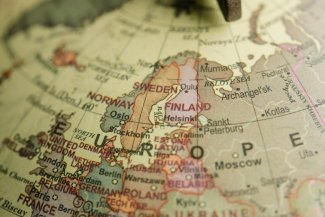The Baltic states and Finland: fencing themselves off from Russia and Belarus

The migratory pressure on the Polish, Lithuanian and Latvian borders with Belarus which has been ongoing since mid-2021, as well as Russia’s full-scale invasion of Ukraine, have spurred the Baltic states and Finland to ramp up their investments in border infrastructure. The construction work is currently at different stages in each of these countries, and there are some differences between them as regards the final shape of the planned border reinforcements. This is partly due to different terrain, but the primary reason is that these countries’ governments have differing perceptions of the threat. Estonia’s and Finland’s actions are preventive, while Lithuania and Latvia have been facing real pressure from Belarus.
Plans to construct barriers and instal sensors and cameras on the borders of the Baltic states emerged even before 2014. Many arguments to justify the need for such efforts were put forward: the need to counter both illegal migration and criminal activity (smuggling) as well as possible provocations from Belarus and Russia. Most of these plans (except those of Lithuania) were suspended or abandoned at a very early stage. However, in the wake of the migration crisis on the border with Belarus, the old projects are now being implemented once again, often in updated forms. In Finland, meanwhile, the issue of reinforcing the border infrastructure did not arise until after the Russian invasion of Ukraine in 2022. None of the countries discussed have faced socio-political polarisation over their decisions to build barriers on their borders.
Lithuania: the regional frontrunner
Lithuania’s external borders with non-EU countries are 953 km long, including 679 km with Belarus and 274 km with Russia. The latter border largely runs along natural obstacles: rivers, lakes and the Curonian Lagoon. The former partly follows rivers and lakes in rough, swampy terrain, but in some places it also runs through inhabited areas.
The debate about erecting barriers on Lithuania’s borders intensified after 2014. The main reasons for the decision to modernise the border infrastructure included the fight against smuggling and illegal migration as well as the prevention of border provocations. Initially, priority was given to the construction of the Russian section, while the Belarusian part was to be built later.
Work on the border with Russia was completed first. As early as 2017 a 45-km-long, two-metre-high fence was put up; it was equipped with an electronic monitoring system, which was then extended to cover the areas along the river Neman marking the border. However, work on the Belarusian section, which posed a much more difficult challenge due to the terrain, was not completed[1] in 2020 as planned. The efforts to expand this infrastructure were only stepped up in the wake of the 2021 migration crisis. Within a year and a half, 529 km of four-metre-high fencing was erected on the border with Belarus and 356 km of razor wire was laid in parallel; the installation of electronic monitoring systems was completed in the spring of 2023. A roughly 100-kilometre section runs along watercourses where the fence cannot be built. The Lithuanian interior ministry has said that the entire strip bordering Belarus is currently being monitored. The next step in the plans is to lay out patrol roads along this strip.
Lithuania has earmarked €3.6 million to reinforce its border with Kaliningrad oblast, including €1.3 million for the construction of the fence[2] and the rest for the monitoring system. The costs of the border infrastructure on the Belarusian section are many times higher. The Lithuanian government has earmarked €152 million for this purpose.
Latvia: the weakest link
Latvia has borders with Russia to the east (283.6 km) and with Belarus to the southeast (173 km). This is a land border which stretches through dense forests and wetlands. Officially, there are 14 crossings (rail, pedestrian and vehicular) that handle border traffic, seven each on the Belarusian and Russian sections. The concept of building infrastructure on Latvia’s eastern border with Russia was conceived as early as 2011, but it was not implemented. The issue of erecting a fence re-emerged after Russia’s invasion of Ukraine in 2014, and preparations for this project continued in the following years. The decisions to build the Russian and Belarusian sections were formally taken in 2015 and 2016 respectively. The work has so far been partially completed: several companies have been involved in the project over the following years (the interior ministry contracted some of them), but they have largely failed to fulfil their obligations.
Construction on the Latvian-Belarusian border only picked up in 2021, when the state-owned company VNĪ took over responsibility for the work from the interior ministry. The first phase (85.8 km) is currently being finalised while the second phase (63.9 km) only started relatively recently. Work on the latter will continue until the third quarter of 2024; the entire project is due to be completed by December next year. The construction of the fence on the Latvian-Belarusian border has taken the longest time even though it is the shortest of all the borders of countries that have faced migratory pressure from Belarus.
Only parts of the barrier on the Latvian-Russian border have so far been completed, while the sections of the fence that were built by 2019 have not yet been put into use. In the project’s previous phase (up to 2019), patrol roads were built along 230 km of the border and 90 km of fence was erected. Work will restart in 2025 and include the remaining 180 km of fencing and 53 km of patrol roads. An audit of the infrastructure that has been built so far will be carried out in the coming months.
There is no publicly available information about the perimeter (including such features as cameras and sensors) that will be built along with the border fence; we only know that the interior ministry has plans for such installations. The head of the company that is carrying out the construction work has emphasised that until the electronic systems are installed, the fence will only slow down people who cross the border illegally. The state-owned company LVRTC is responsible for the future construction and implementation of the technical infrastructure.
Unlike the other countries in the region that have been expanding their border infrastructure, Latvia has not published information on its total or estimated costs.
Estonia: a cautious approach
The Russian-Estonian border[3] runs for 333.7 km, including 207.5 km on land and rivers and 126.2 km along three interconnected lakes: Pskov, Lämmi and Peipus. For the most part, it crosses natural obstacles: it follows the bed of the River Narva from the Gulf of Finland to Lake Peipus, but runs mainly on land south of these lakes to the border with Latvia. There are seven border crossings along the entire demarcation line, including pedestrian, vehicular and two rail crossings (one of which is exclusively for freight).
The idea of building a fence and upgrading the infrastructure on the border with Russia was conceived in 2018, but work did not start until after the migration crisis broke out on the Belarus-EU border in 2021. The fast-track decision on this issue was prompted by the government’s fears that migratory pressure would spread to the Estonian-Russian border.
Since 2021, the government in Tallinn has been building infrastructure along the most important southern section of the border, where a razor wire fence equipped with electronic devices is under construction. The interior ministry has said that it will be erected along the entire land border, including sections which are difficult to reach such as swamps, peat bogs, backwaters and headlands. The infrastructure on the land border with Russia is expected to total 135.6 km; construction has been divided into three phases that will initially involve the erection of about 115 km of the barrier. The first test section (23.5 km) was completed last summer. Construction work is currently underway as part of the second phase (c. 40 km). Work on the third section of about 50 km is scheduled for 2024. The total budget for the project to reinforce the country’s southeastern border is €147 million.
The barrier on the Estonian-Russian border will be equipped with a state-of-the-art perimeter system. According to the interior minister Lauri Läänemets, it will be fully secure: the network which regulates the equipment will be a cable network, thus ensuring that the Estonians have full and exclusive control over the entire technical infrastructure. According to the assumptions of the Estonian interior ministry, it will be more modern than those on the Lithuanian-Belarusian and Polish-Belarusian borders after its completion, scheduled for 2025. However, the ministry has not disclosed any details on this.
Finland: a partial barrier
Several sections of barriers on the border with the Russian Federation are under construction in Finland. The initiative to erect them came from the Finnish Border Guard (Rajavartiolaitos) in 2022.[4] After watching the migratory pressure on the Polish, Lithuanian and Latvian borders with Belarus, it concluded that such a solution in Finland would also have to be implemented in order to prevent similar tensions on the Finnish-Russian border in the future. In October 2022, the government decided to grant funding for the construction of a trial section of the barrier.[5] The broad acceptance of this idea among the country’s political class stemmed from concerns about anticipated Russian hybrid operations in retaliation for Finland’s decision to join NATO.
Finland has already experienced migratory pressure on its border with Russia. In 2015 Russia opened the Arctic migration route through Murmansk to the Norwegian and Finnish border crossings in the far north, partly in response to Finland’s policy of limiting bilateral contacts, which it had instituted after Russia’s annexation of Crimea and its intervention in eastern Ukraine.[6] This step was also intended to spur Finland into making efforts to normalise relations between the European Union and Russia, and exercising restraint in developing cooperation with NATO and within the region. Some 32,500 asylum applications were filed in Finland in 2015 (most of which involved people from the Middle East), nine times more than in 2014. This surge in the number of migrants increased the threat of terrorism and the influence of Islamic fundamentalists; it also stoked anti-immigrant sentiments, which was reflected in regular attacks on reception centres and the emergence of far-right militias.[7]
Finland has no plans to build a continuous fence along the entire Finnish-Russian border, which stretches for over 1340 kilometres. It will build only eight sections with a total length of 200 kilometres, located at every permanent road border crossing, mainly along the southeastern section of the border.[8] This is because the highest concentrations of population and infrastructure on both sides of the border are found in this section of the frontier. According to the Finnish Border Guard, this is also the most convenient area for Russia to conduct hybrid operations against Finland.[9] It is known that the barriers will be of different length, but so far no details regarding their construction have been revealed.
In April 2023, Finland began work on a three-kilometre section of a trial barrier in Imatra (South Karelia), which was already completed by June, and the solutions adopted are currently being tested. The government has decided to erect a simple metal fence topped with razor wire, along with a road for Border Guard vehicles and poles with cameras. The next phase will start this autumn, with the land for the section near the Salla border crossing (Lapland) being prepared. The barrier’s construction is set to begin in spring 2024 and continue until summer 2025. The total cost of erecting all the barriers has been estimated at around €380 million; all the sections are scheduled for completion by 2026.[10]
Conclusions
The migratory pressure coordinated by the Belarusian government has been the decisive factor for the construction of the barriers on the EU’s external borders in the Baltic states. These countries have resumed the construction work and the implementation of concepts that had earlier been suspended. Latvia has mainly focused on reinforcing the Belarusian section, which was not a priority before. Meanwhile, Estonia has begun to pay more attention to its southeastern border due to fears that it may face migratory pressure from Russia.
The Baltic states have taken different approaches to the issue of expanding the existing border infrastructure and developing it with new features (including barriers, the monitoring system and proper roads). The various types of work have been carried out at different speeds. Lithuania has implemented its projects at the fastest pace, which is related to the scale of the challenges and the relatively early start of the work (on the border with Russia). The construction of this infrastructure is also a priority for its interior ministry because Lithuania shares the longest border with Belarus of all the countries in the region. On the other hand, Latvia has proceeded at the slowest pace, despite the fact that it has also faced migratory pressure from Belarus. This stems from the arduousness of working in difficult terrain (deforesting the frontier areas) as well as internal problems (improper practices in tenders and construction).[11] Unlike the other Baltic states, Estonia has not faced direct migratory pressure on its borders; the government in Tallinn has taken its steps in anticipation of possible threats.
Finland was the last to decide to build a barrier on its eastern border. This was prompted by concerns over the migratory pressure on Poland, Lithuania and Latvia in 2021, as well as fears of Russian provocations following the announcement of Finland’s accession to NATO. The plans to build a fence on its border differ from those that the Baltic states have been implementing. Unlike its southern neighbours, Finland has no plans to expand infrastructure along the entire length or even most of its border. This primarily stems from its sheer length (1340 km) and the uneven population density of the border areas on the Finnish and Russian sides.
The border infrastructure under construction in Finland and the Baltic states also differs in technical parameters, such as the height of the fences (those along the Belarusian-Lithuanian section are the highest) and the degree of its technological advancement. According to the statements by the relevant ministers, the perimeters on the Lithuanian and Estonian sections will be based on different standards. Work on the electronic layer is currently most advanced in Lithuania, while Estonia has provided the most information about its plans in this field. In contrast, Latvia has not yet detailed its intentions to supplement the barrier with an electronic layer. All we know is that such a system is supposed to be created in the more distant future. The situation is similar in Finland: its current plans do not include such equipment, and it has yet to take a decision on the final shape of the perimeter at its border (only its general design is in place).
In each of the countries discussed, the concepts of expanding border installations do not arouse major political controversy, and are not a polarising factor in society. The Baltic states and Finland have taken their decisions based on a broad consensus among their political elites. The projects adopted by the previous governments are being continued by their political opponents currently in power. Only in Finland was the minor Left Alliance critical of the idea to expand border infrastructure, but even though it was part of the governing coalition, its stance did not have affect the final decision to build the barriers.
Map. Progress in the expansion of border barriers in the Baltic states and Finland

Source: the authors’ own compilation based on maps and information published by the border guards and the interior ministries of the Baltic states and Finland.
[1] The original plans were probably not implemented due to changes in government priorities.
[2] S. Gudavičius, ‘Pradedama statyti tvora pasienyje su Kaliningrado sritimi’, Verslo žinios, 5 June 2017, vz.lt; ‘Pasienyje su Rusija bus baigta statyti apsauginė tvora’ 15min, 20 December 2017, 15min.lt.
[3] Estonia is the only country in the region that has not fully resolved its border issues with Russia. This means that the border is the subject of a symbolic and legal dispute between the two countries. A 2014 border treaty regulates its course, but to date it has not been ratified by either side. This stems from references in the document to the Treaty of Tartu of 2 February 1920 and the border that was established under that agreement. Russia does not want to ratify this agreement precisely for this reason. Before World War II, the present city of Ivangorod (formerly Estonian Jaanilinn) and the Pechora region were within the borders of the Estonian state.
[4] The Finnish Border Guard (Rajavartiolaitos) is a service under the Ministry of the Interior.
[5] ‘Fence on the eastern border and rescue services to receive the largest budget increases in the Ministry of the Interior’s branch of government’, Ministry of the Interior of Finland, 17 November 2022, intermin.fi/en.
[6] Norway remains the only NATO country that shares a land border with Russia (195.7 km, including 106 km along the Paatsjoki River), and is not currently building new barriers. In 2016, a protective fence of around 200 metres in length was erected at the only border crossing in Storskog. In addition, a netting separates the two countries near the Skafferhullet crossing, which was closed in 1966. There is also a 150-kilometre-long wire and wood barrier along the border to prevent reindeer migration (built in 1954).
[7] P. Szymański, P. Żochowski, W. Rodkiewicz, ‘Enforced cooperation: the Finnish-Russian migration crisis’, OSW, 6 April 2016, osw.waw.pl.
[8] Finland has eight permanent road border crossings with Russia. From the north, these are: Raja-Jooseppi and Salla (Lapland), Kuusamo (Northern Ostrobothnia), Vartius (Kainuu), Niirala (North Karelia), Imatra and Nuijamaa (South Karelia), and Vaalimaa (Kymenlaakso). In addition, there is a railway crossing in Vainikkala (South Karelia), but no border barrier will be built there.
[9] ‘Usein kysyttyä itärajan esteaidasta’, Rajavartiolaitos, raja.fi.
[10] ‘Itärajan esteaita’, Rajavartiolaitos, raja.fi.
[11] In August 2022, the public prosecutor’s office opened six criminal proceedings related to irregularities in the construction of border infrastructure; these concern fraud and embezzlement, and involve officials, entrepreneurs and private individuals.




